sensor Lexus GS350 2007 Using the front audio system / LEXUS 2007 GS430/350 OWNER'S MANUAL (OM30A04U)
[x] Cancel search | Manufacturer: LEXUS, Model Year: 2007, Model line: GS350, Model: Lexus GS350 2007Pages: 562, PDF Size: 17.95 MB
Page 25 of 562
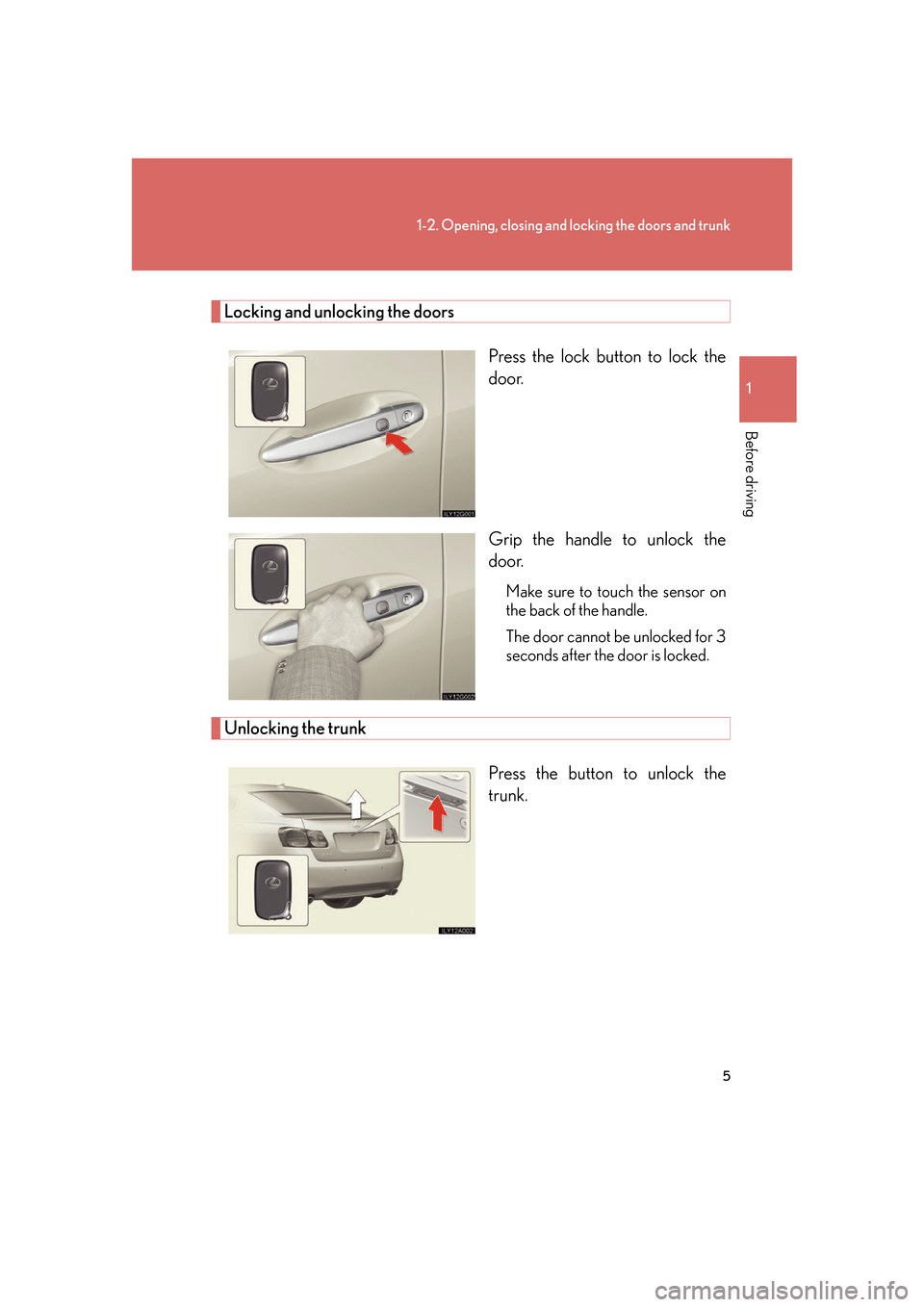
5
1-2. Opening, closing and locking the doors and trunk
1
Before driving
Locking and unlocking the doors
Press the lock button to lock the
door.
Grip the handle to unlock the
door
.
Make sure to touch the sensor on
the back of the handle.
The door cannot be unlocked for 3
seconds af
ter the door is locked.
Unlocking the trunk
Press the button to unlock the
trunk.
Page 55 of 562
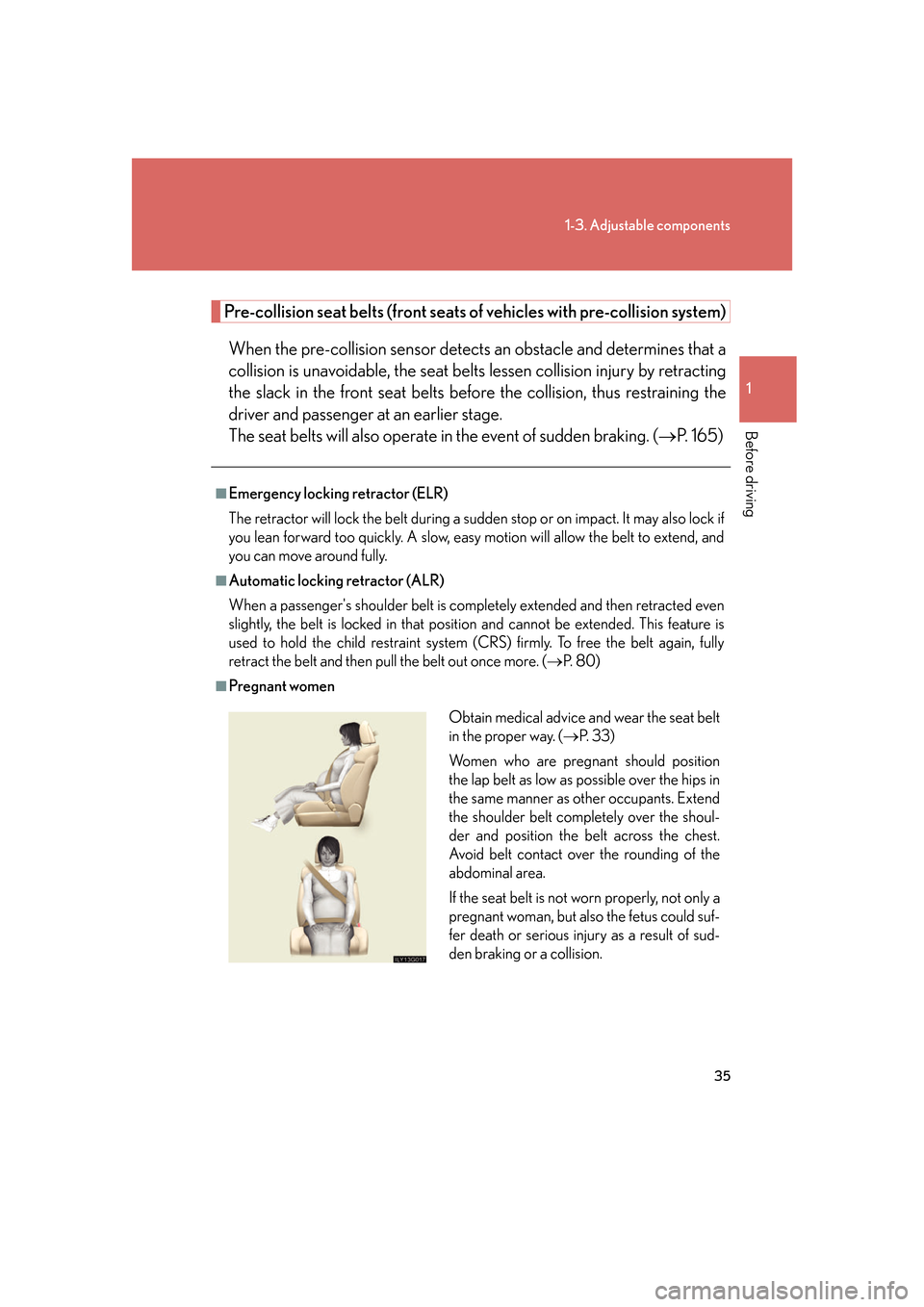
35
1-3. Adjustable components
1
Before driving
Pre-collision seat belts (front seats of vehicles with pre-collision system)
When the pre-collision sensor detects an obstacle and determines that a
collision is unavoidable, the seat belt s lessen collision injury by retracting
the slack in the front seat belts befo re the collision, thus restraining the
driver and passenger at an earlier stage.
The seat belts will also operate in the event of sudden braking. ( P. 1 6 5 )
■Emergency locking retractor (ELR)
The retractor will lock the belt during a sudd en
stop or on impact. It may also lock if
you lean forward too quickly. A slow, easy motion will allow the belt to extend, and
you can move around fully.
■Automatic locking retractor (ALR)
When a passenger's shoulder bel
t is completely extended and then retracted even
slightly, the belt is locked in that position and cannot be extended. This feature is
used to hold the child restraint system (CRS) firmly. To free the belt again, fully
retract the belt and then pull the belt out once more. ( P. 8 0 )
■Pregnant women
Obtain medical advice and wear the seat belt
in the proper way. ( P. 3 3 )
Women who are pregnant should position
the lap belt as low as possible over the hips in
the same manner as other occupants. Extend
the shoulder belt completely over the shoul-
der and position the belt across the chest.
Avoid belt contact over the rounding of the
abdominal area.
If the seat belt is not worn properly, not only a
pregnant woman, but also the fetus could suf-
fer death or serious injury as a result of sud-
den braking or a collision.
Page 60 of 562
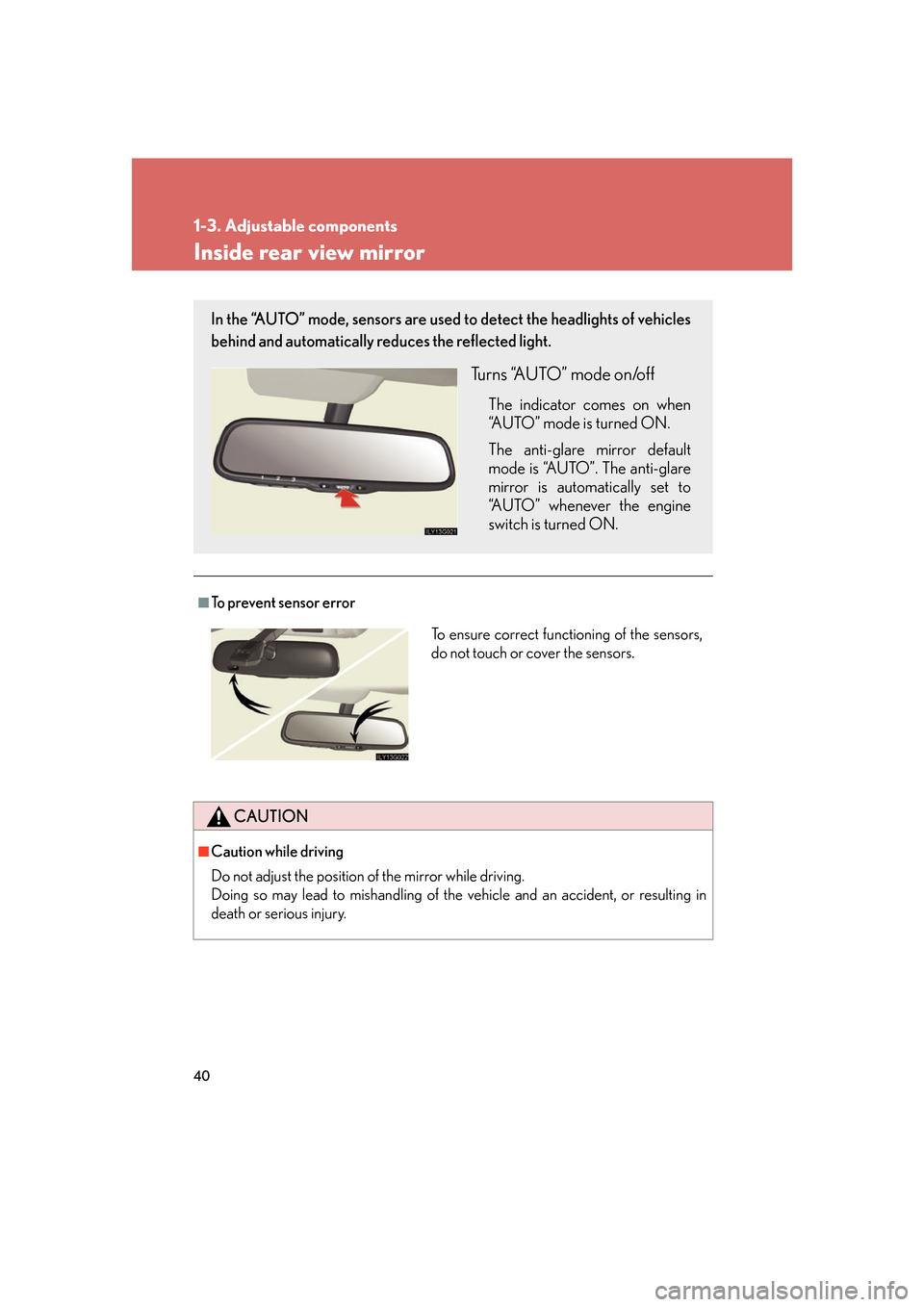
40
1-3. Adjustable components
Inside rear view mirror
■To prevent sensor error
CAUTION
■Caution while driving
Do not adjust the position of the mirror while driving.
Doing so may lead to mishandling of the vehicle and an accident, or resulting in
death or serious injury.
In the “AUTO” mode, sensors are used to detect the headlights of vehicles
behind and automatically re duces the reflected light.
Turns “AUTO” mode on/off
The indicator comes on when
“AUTO” mode is turned ON.
The anti-glare mirror default
mode is “
AUTO”. The anti-glare
mirror is automatically set to
“AUTO” whenever the engine
switch is turned ON.
To ensure correct functioning of the sensors,
do not touch or cover the sensors.
Page 80 of 562
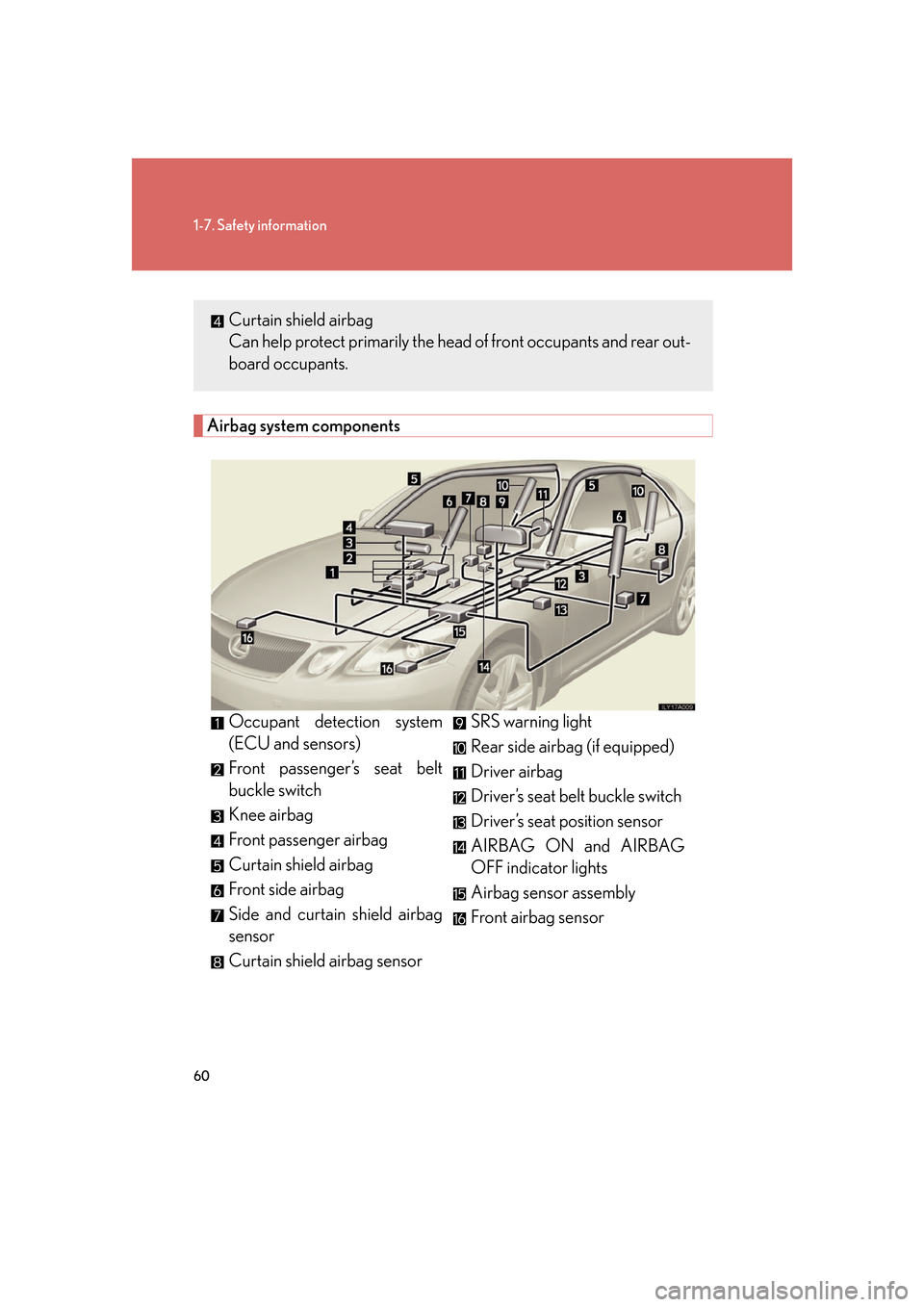
60
1-7. Safety information
Airbag system components
Occupant detection system
(ECU and sensors)
Front passenger’s seat belt
buckle switch
Knee airbag
Front passenger airbag
Curtain shield airbag
Front side airbag
Side and curtain shield airbag
sensor
Curtain shield airbag sensorSRS warning light
Rear side airbag (if equipped)
Driver airbag
Driver’s seat belt buckle switch
Driver’s seat position sensor
AIRBAG ON and AIRBAG
OFF indicator lights
Airbag sensor assembly
Front airbag sensor
Curtain shield airbag
Can help protect primarily the head of fr
ont occupants and rear out-
board occupants.
Page 81 of 562

61
1-7. Safety information
1
Before driving
Your vehicle is equipped with ADVANCED AIRBAGS designed based
on US motor vehicle sa fety standards (FMVSS208). The airbag system
controls airbag deployment power for the driver and front passenger. The
driver airbag system consists of the driver seat’s position sensor etc. The
front passenger’s airbag system consist s of the front passenger occupant
classification sensor etc.
In certain types of severe frontal or side impacts, the SRS airbag s
ystem
triggers the airbag inflators. A chemica l reaction in the inflators quickly
fills the airbags with non-toxic gas to help restrain the motion of the occu -
pants.
■If the SRS airbags deploy (inflate)
●Bruising and slight abrasions may result from contact with a deploying (inflating)
SRS airbag.
●A loud noise and white powder will be emitted.
●Parts of the airbag module (steering wheel hub, airbag cover and inflator) as
well as the seats, and parts of the front and rear pillars, and roof side rail, may be
hot for several minutes. The airbag itself may also be hot.
●The windshield may crack.
Page 137 of 562
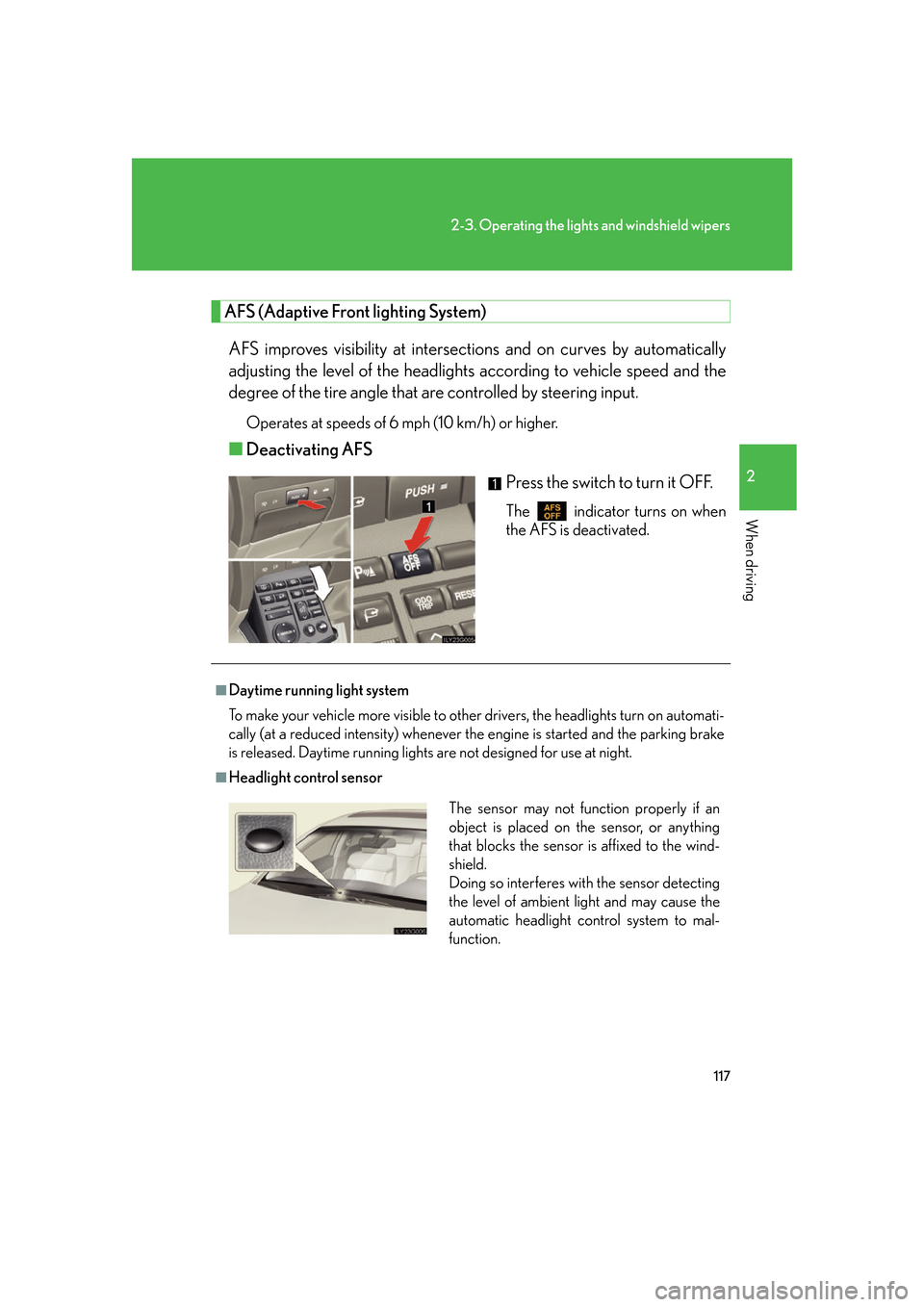
117
2-3. Operating the lights and windshield wipers
2
When driving
AFS (Adaptive Front lighting System)
AFS improves visibility at intersectio ns and on curves by automatically
adjusting the level of the headlights according to vehicle speed and the
degree of the tire angle that are controlled by steering input.
Operates at speeds of 6 mph (10 km/h) or higher.
■ Deactivating AFS
Press the switch to turn it OFF.
The indicator turns on when
the AFS is deactivated.
■Daytime running light system
To make your vehicle more visible to other drivers, the headlights turn on automati -
cally (at a reduced intensity) whenever the engine is started and the parking brake
is
released. Daytime running lights are not designed for use at night.
■Headlight control sensor
The sensor may not function properly if an
object is placed on the sensor, or anything
that blocks the sensor is affixed to the wind-
shield.
Doing so interferes with the sensor detecting
the level of ambient light and may cause the
automatic headlight control system to mal-
function.
Page 138 of 562
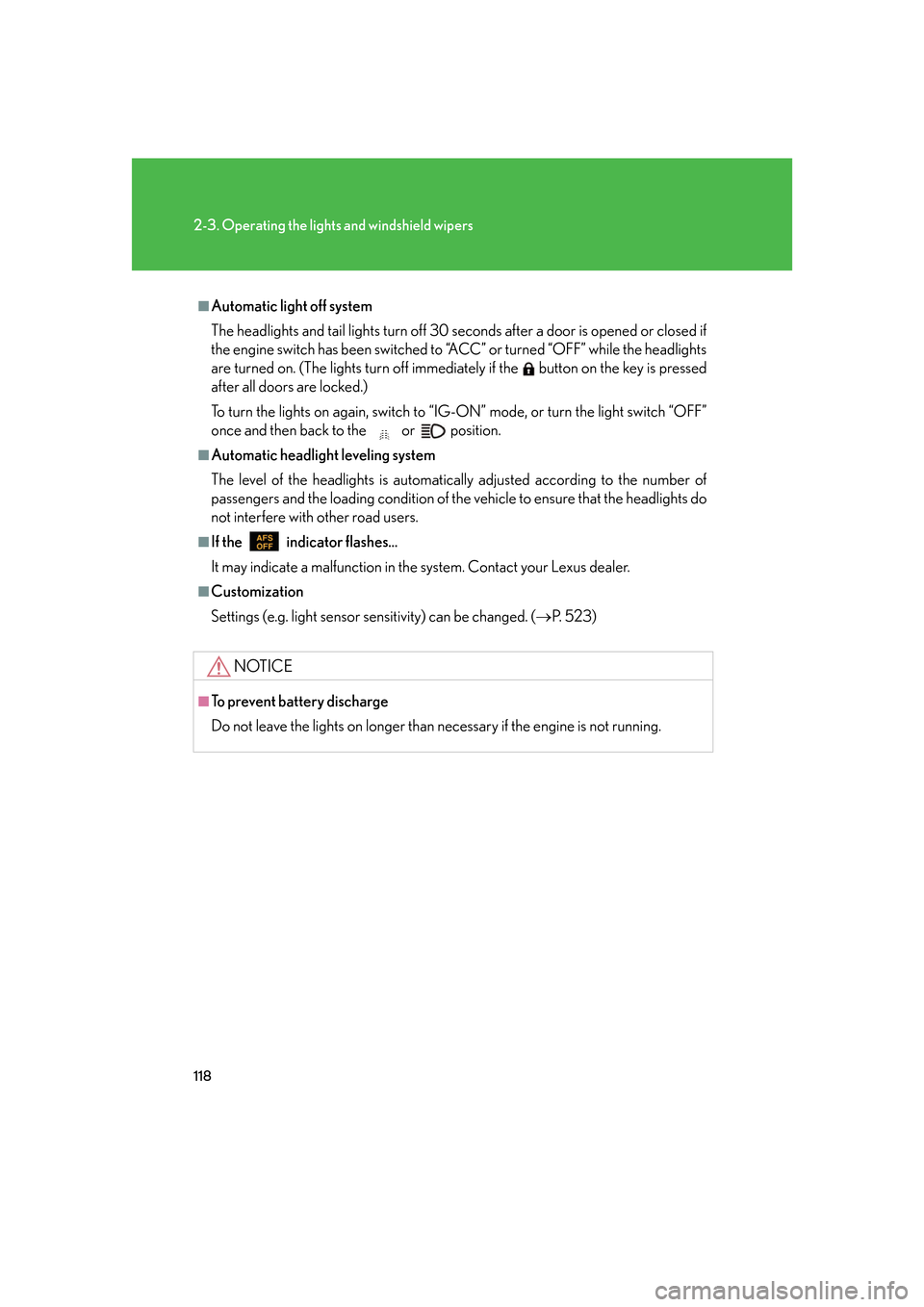
118
2-3. Operating the lights and windshield wipers
■Automatic light off system
The headlights and tail lights turn off 30 seconds after a door is opened or closed if
the engine switch has been switched to “ACC” or turned “OFF” while the headlights
are turned on. (The lights turn off immediately if the button on the key is pressed
after all doors are locked.)
To turn the lights on again, switch to “IG-ON” mode, or turn the light switch “OFF”
once and then back to the or position.
■Automatic headlight leveling system
The level of the headlights is automatica lly adjusted according to the number of
passengers and the loading condition of the vehicle to ensure that the headlights do
not interfere with other road users.
■If the indicator flashes...
It may indicate a malfunction in the system. Contact your Lexus dealer.
■Customization
Settings (e.g. light sensor sensitivity) can be changed. ( P. 5 2 3 )
NOTICE
■To prevent battery discharge
Do not leave the lights on longer than necessary if the engine is not running.
Page 140 of 562

120
2-3. Operating the lights and windshield wipers
Windshield wipers and washer
■Intermittent wiper with interval adjuster (if equipped)
Wiper intervals can be adjusted for intermittent operation (when
“INT” is selected).
Intermittent wiper interval
adjustment (increase)
Intermittent wiper interval
adjustment (decrease)
Intermittent wiper operation
Low speed wiper operation
High speed wiper operation
Temporary operation
Wash/wipe operation
■ R
ain-sensing windshield wipers (if equipped)
With “AUTO” selected, the wipers will oper
ate automatically when
the sensor detects falling rain. The system automatically adjusts
wiper timing in accordance with rain volume and vehicle speed.
Sensor sensitivity (low)
Sensor sensitivity (high)
Rain-sensing wiper operation
Low speed wiper operation
High speed wiper operation
Temporary operation
Wash/wipe operation
Page 141 of 562

121
2-3. Operating the lights and windshield wipers
2
When driving
■The windshield wiper and washer can be operated when
The engine switch is in “IG-ON” mode.
■Dripping prevention wiper sweep
After washing and wiping operation severa l
times, the wipers operate one more
time after a short delay to prevent dripping.
However, the last sweep will not happen if the vehicle is traveling above 106 mph
(1
70 km/h).
■Effects of vehicle speed on wiper operation
Vehicle speed affects the following even when the wipers are not in “AUTO” mode.
●Intermittent wiper interval (“INT” mode)
●Wiper operation when the washer is bein g used (delay until drip prevention
wiper sweep occurs)
With “LO” selected, wiper operation will be
switched from low speed to intermit-
tent wiper operation only when the vehicle is stationary.
■Rain drop sensor (vehicles equipped with the rain-sensing windshield wipers)
The sensor judges the amount of raindrops.
Page 142 of 562

122
2-3. Operating the lights and windshield wipers
■If no windshield washer fluid sprays
Check that the washer nozzles are not blocked if there is washer fluid in the wind-
shield washer fluid reservoir.
■In extremely hot or cold weather
The system will turn off if the windshield gets extremely hot (at more than 176°F
[80°C]) or cold (at less than 14°F [-10°C]).
■Customization
Settings (e.g. drip prevention function) can be changed. (P. 5 2 6 )
CAUTION
■Caution regarding the use of windshield wipers in “AUTO” mode
The windshield wipers may operate unexpect edly if the sensor is touched or the
windshield is subject to vibration in “AUTO” mode. Take care that your fingers or
anything else do not become caught in the windshield wipers.
NOTICE
■When the windshield is dry
Do not use the wipers, as they may damage the windshield.
■When there is no washer fluid spray from the nozzle
Damage to the washer fluid pump may be caused if the lever is pulled toward you
and held continually.
■When using an automatic car wash
(vehicles equipped with the rain-sensing windshield wipers)
Set the wiper switch to “OFF”.
If the wiper switch is in “AUTO”, the wipers
may operate and the wiper blades may be
damaged.
OFF
AUTO